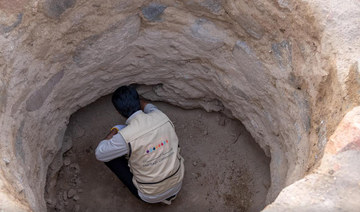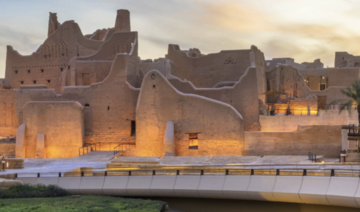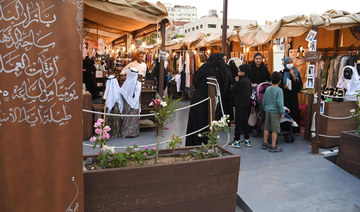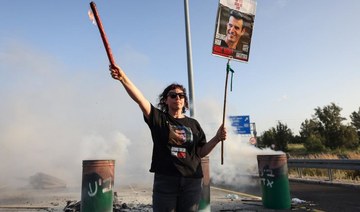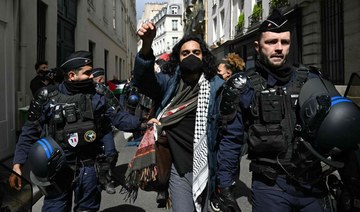MUMBAI: Heartbroken fans Monday awaited the arrival of the body of Bollywood superstar Sridevi Kapoor as tributes poured in for the actress who died in Dubai of a heart attack aged just 54.
Hundreds gathered outside her Mumbai home hoping to catch a final glimpse of the star before she is cremated at a funeral service expected later Monday.
Sridevi — one of the biggest names in Hindi cinema — died late on Saturday after suffering a cardiac arrest in Dubai, where she had been attending her nephew’s wedding.
Her body was due to be flown back to Mumbai on Monday on a charter flight after authorities in the emirate allowed it to be released following a post mortem.
“We want to see her one last time,” 48-year-old Laxmi Subbaramaiah told AFP outside Sridevi’s house in the Andheri area of Mumbai — the heartland of the Bollywood film industry.
“All of my family members are big fans and we cried when we heard the news. We will wait here until her body comes back,” he said.
Vishal More, 23, said he had traveled seven hours from Jalgaon district, around 400 kilometers away from Mumbai, to bid farewell to his favorite actress.
“I’ve been waiting all morning to catch a last glimpse of Sridevi. I have watched all of her movies. She is such an inspiration,” he said.
Sridevi’s death has prompted an outpouring of grief in India from fans and fellow actors as well as condolences from Prime Minister Narendra Modi.
“I have always been a huge fan of her work. Equally I have been an admirer of the grace and dignity with which she conducted herself,” actor Aamir Khan wrote on Twitter.
“I join all the millions of her fans in mourning her demise. Ma’am we will always remember you with love and respect,” he added.
Fellow actor Ranveer Singh tweeted that he was “shocked and saddened to hear about the untimely demise of one of Hindi cinema’s greatest superstars.”
Actress Alia Bhatt posted on Twitter: “Nothing makes sense. I have no words.. just completely shocked. RIP Sri Devi. My icon forever. Love you.”
Sridevi, born Shree Amma Yanger Ayappan in the southern state of Tamil Nadu, appeared in around 300 films and was awarded the Padma Shri, India’s fourth highest civilian award, for services to the movie industry.
She made her acting debut at the age of four and her career spanned more than four decades.
Sridevi worked in India’s regional Tamil, Telugu and Malayalam-language films before making her Bollywood debut in 1979.
She became a national icon with a string of blockbuster films including “Chandni,” “Mr India,” “Mawali” (“Scoundrel“) and “Tohfa” (“Gift“).
Sridevi famously took a 15-year-break from the silver screen after marrying film producer Boney Kapoor but returned in the 2012 hit comedy-drama “English Vinglish.” Her most recent film was last year’s “Mom.”
She was set to see Jhanvi, the eldest of her two daughters, make her Bollywood debut.
India mourns death of Bollywood actress Sridevi
India mourns death of Bollywood actress Sridevi

Saudi Heritage Commission event celebrates ancient Rakah
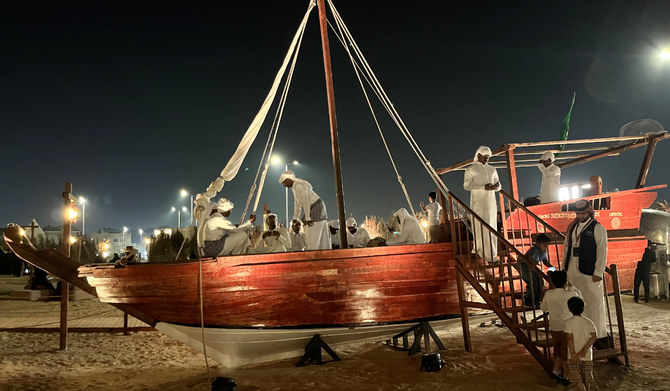
- “We want our customers to enter our space, either in our booth at the event this week or our studio location, and in just a short time be able to produce something customized to take home, she told Arab News
DAMMAM: The Heritage Commission is holding an event to celebrate ancient Rakah, with historical reenactments, guided tours, archaeological experts and handicrafts.
Once a major trading spot, some 1,500 years ago, the area takes its name from an indigenous tree species that once flourished there. The sandy environment was also once under the sea and shells can be found still glued to the rocks.
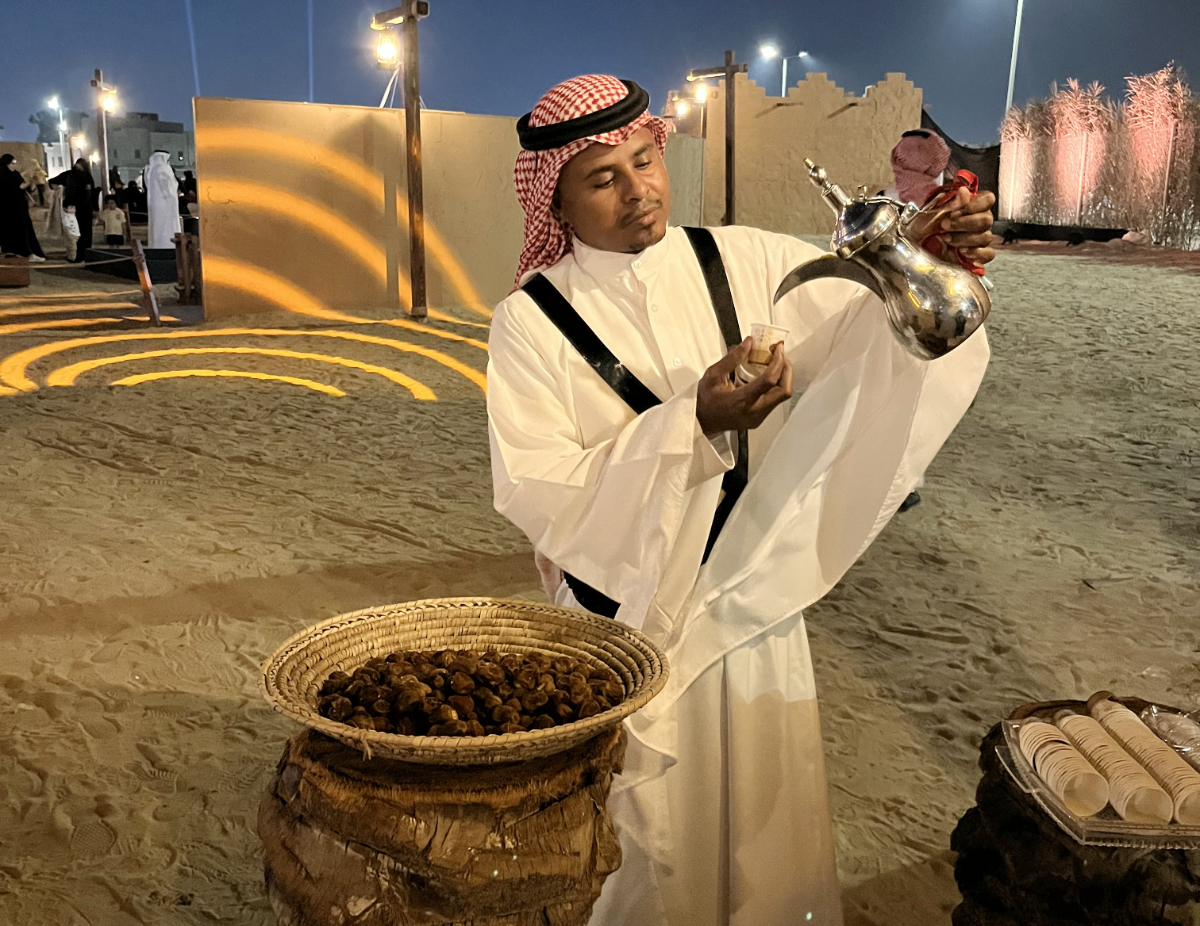
Many of the guides are female archaeology graduates from Imam Abdulrahman Bin Faisal University, formerly known as the University of Dammam.
Wala Al-Nafaiai, who co-founded Dam Studio, a local business that specializes in handmade goods made of cow and camel hide, said she was looking forward to showing off her products to visitors.
FASTFACTS
● Once a major trading spot, some 1,500 years ago, the Rakah area in Dammam takes its name from an indigenous tree species that once flourished there.
● The sandy environment was also once under the sea and shells can be found still glued to the rocks.
“We want our customers to enter our space, either in our booth at the event this week or our studio location, and in just a short time be able to produce something customized to take home, she told Arab News.

“Instead of going to a restaurant, we want you to spend the time to have an experience, produce something practical and learn skills you can utilize later.”
Al-Nafaiai said she was delighted with how many people had taken part in the workshops she provided at her booth.
It seems many (people) enjoy customizing something that they feel connected to once they make it with their own hands.
Wala Al-Nafaiai, Dam Studio co-founder
“It was so crowded … I was surprised that there were more adults than children who wanted to join in, although the craft was very simple,” she said.
“It seems many (people) enjoy customizing something that they feel connected to once they make it with their own hands. And that is our goal and the goal of the Heritage Commission who invited us to join this successful event.”

Visitors were also able to learn about the importance of dates to the community in ancient times and how local people would make and trade date syrup with visiting merchants.
Organized in cooperation with the Sharqiya Development Authority, the festival ends on Tuesday. For more information, visit heritage.moc.gov.sa or @mocheritage.
Riyadh forum highlights importance of cultural identity and Arab heritage
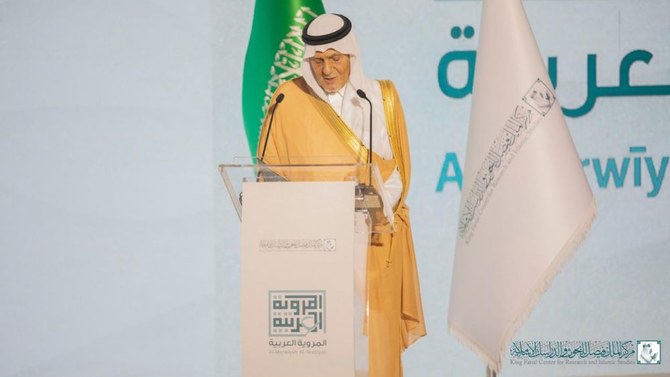
- Scholars, officials, experts explore and celebrate Arabian Peninsula
- Katakura Kunio said that both Japanese and Islamic cultures had historic roots in promoting peace
RIYADH: The Al-Marwiyah Al-Arabiyah Conference, called “Desert Culture,” concluded on Monday in Riyadh. The two-day event brought together a diverse group of scholars, officials, and experts to explore and celebrate the rich cultural heritage of the Arabian Peninsula.
Prince Turki Al-Faisal, the chairman of the King Faisal Center for Research and Islamic Studies, said that nomadism was central to Arab culture, emphasizing its roots in values over materialism. He noted that Arabs were natural storytellers, adept at turning chaos into clarity.
Katakura Kunio, president of the Motoko Katakura Foundation for Desert Culture in Japan, delivered a speech in memory of his late wife, anthropologist Motoko Katakura, which highlighted her research in Saudi Arabia.
Kunio said: “Motoko’s enduring passion for comfort inspired our foundation to establish the Comfort Prize, aimed at supporting both Japanese and international researchers and artists. This award honors individuals who dedicate their lives to enriching desert culture.
“In the current climate of positive change within Saudi Arabia, including the increased societal participation of women and the focus on tourism development, it is natural to re-evaluate the traditional value of comfort. Perhaps, in a world increasingly driven by hyper-capitalism, comfort can offer a remedy for the global population yearning for a slower pace.”
Kunio said that both Japanese and Islamic cultures had historic roots in promoting peace. He noted that Prince Shotoku of Japan endorsed “respect for peace” in his 17-Article Constitution, while the Prophet Muhammad established the Madinah Charter, which also emphasized peace and tolerance. These parallels suggested a common ground for fostering cross-cultural understanding, he added.
Abdullah Hamidaddin, assistant secretary-general for scientific affairs at the KFCRIS, described Al–Marwiyah Al-Arabiyah as a research initiative which aimed to address confusion about Arab civilization. It sought to combat attempts to undermine and marginalize Arab culture.
Hamidaddin said that the project used scientific methods to study Arab narratives and the origin of language in the Arabian Peninsula, while promoting dialogues, field studies, and critical analyses in various fields, including history, archaeology, sociology, philosophy, literature, and art.
The conference aimed to highlight the civilizational and cultural significance of the Arabian Peninsula, while seeking to strengthen the sense of Arab identity for future generations. It also promoted cultural exchange between the Arab world and neighboring regions.
A lecture titled “Gifts of God (Camels),” by Sulaiman Al-Theeb, cultural adviser at the center, was presented during the conference.
He spoke of the Arabian Peninsula’s deep connection with camels through three key concepts: rock and mural art; archaeological finds, like daily tools; and references to camels in ancient Arabic inscriptions, especially Thamudic writings.
Al-Theeb highlighted the significant status of camels in the region, which has earned them the moniker “the ship of the desert.”
Mohammed Al-Rowaily, a member of the Cultural Council at the Abdulrahman Al-Sudairy Cultural Center, said that the Arabic narrative played a crucial role in sharing ideas with others. He noted that Arabic storytelling enhanced cross-cultural understanding by conveying elements from history, oral literature, civilization, arts, and other creative works.
Hajar Al-Shammari, a linguistic researcher in Saudi history, said that the event boosted cultural engagement by fostering dialogue and cultural exchange among academics. Through the sharing of ideas it helped to establish a foundation for field studies and critical analyses focused on Arab perceptions and identity.
Al-Shammari added that Arabic storytelling played a significant role in promoting social cohesion, fulfilling the search for roots, and reinforcing values. This was especially important in the context of cultural identity and Arab heritage.
Moroccan photographer Hassan Hajjaj captures the culture of AlUla

- The acclaimed Moroccan photographer discusses his recent show in Saudi Arabia
DUBAI: Early in February this year, Moroccan contemporary artist and photographer Hassan Hajjaj was given a reminder of just how high his star has risen. Within a few days of each other, Hajjaj had shows opening in the US, Morocco, and — as part of AlUla Arts Festival — Saudi Arabia.
Hajjaj’s playful portraiture, which incorporates vivid color, funky clothing (almost all of which he designs himself), geometric patterns, and — often — vintage brands from the MENA region, has made him internationally popular, and his instantly recognizable style has established him as one of the world’s leading photographers.
His show in AlUla consisted of images that he shot in the ancient oasis town in February 2023. That visit was initially supposed to involve shoots with around 20 local people. It’s the kind of thing he’s done a few times before, including in Oman and Abu Dhabi. “It’s always a good opportunity to get to know the culture and the people,” Hajjaj tells Arab News.
But, as he says himself, he arrived in AlUla as “an outsider,” so needed a team on the ground to persuade locals to come and sit (or stand, in most cases) for him.
“It was a bit tough, in the beginning, for them to find people,” Hajjaj explains. “But because it was during a period when lots of art things were happening in AlUla, there were lots of people coming from outside AlUla as well. So we opened it up. I basically said, ‘Just come.’
“In the end lots of people turned up, not just locals — people from Riyadh, Jeddah, and people (from overseas) too. I think I shot around 100 people over a few days. So it was a great opportunity,” he continues. “To get to shoot that many people over three days — organizing something like that for myself might take a year. So, as long as I have the energy, when I get these opportunities — you know, I’m in AlUla with this eclectic bunch of people — I’d rather go and grind it, really work hard, and have that moment.”
A Hassan Hajjaj shoot isn’t your regular portrait shoot, of course. “It’s almost like a performance,” he says. “There’s music, people dress up, it’s like a day out for them, taking them out of themselves for a few hours.”
He followed the same modus operandi in AlUla. “We got an ambience going. It was fun, there was music… I shot in this beautiful old school that was one of the first girls’ schools in Saudi Arabia, from the Sixties. Upstairs was like a museum — everything was like a standstill from the Seventies and Eighties; even the blackboards had the chalk and the writing from that time,” he says.

A crucial part of Hajjaj’s practice is to ensure that his subjects are at ease and feel some connection with him (“comfortable” is a word he uses several times when talking about his shoots). While all his portraits bear his clearly defined style, it’s important to him that they should also show something unique to the people in them.
“It’s that old thing about capturing the spirit of the person in that split second, you know? I’m trying to get their personality and body language in the image,” he says. “Quite often I’m shooting in the street, outdoors, so (the subjects) can start looking at other people, thinking, ‘Are they looking at me?’ So I usually say, ‘Listen. This is a stage I’m building for you. I’m dressing you up, and we’re going to have fun.’ Then I just try and find that personality that can come out and make the image stronger. With some people, though, saying almost nothing can be better — just getting on with it. I try to kind of go invisible so it’s the camera, not the person, that’s doing the work. The best pictures come out when there’s some kind of comfortable moment between me and the person and the camera.”
It’s the way he’s worked since the beginning — a process that developed organically, as most of his early portraits were of “friends or friends of friends.”

“There’s a comfort in that because you have a relationship with them. It made it easy,” he says. “And that taught me about how important it is to build trust with people to get into that comfortable zone. But as time went on, obviously, people could see the stuff in the press or on social media, so then people started, like, asking to be shot in that manner; maybe they’ve studied the poses of certain people and stuff like that, so they come ready to do some pose they’ve seen in my pictures. That’s quite funny.”
The work that was on display over the past two months in Hajjaj’s “AlUla 1445” is a perfect example of what he tries to achieve with his shoots. The images are vibrant, playful, and soulful, and the subjects run from a local goatherder through the AlUla football team to bona fide superstars: the US singer-songwriter Alicia Keys and her husband Swizz Beatz.
Hajjaj says he has a number of favorites “for different reasons,” including the goatherder.

“He brought in two goats and it became quite abstract when you put all of them together. I was playing with that notion of the person; you could see that’s his life and even the goats look happy,” he explains. “I wanted to make sure they had that shine in the image as well. I got some great shots of him.”
The Alicia Keys and Swizz Beatz shoot has been a long time in the making. Hajjaj first met Swizz Beatz a decade ago, and they have been in touch intermittently ever since. The idea of a shoot with Keys first came up about five years ago, but logistics had always got in the way. But since they were playing a concert in AlUla at the same time as Hajjaj was there, it finally happened, on Hajjaj’s last day, with perhaps an hour left before the light faded.
I ask Hajjaj if his approach to shooting celebrities differs from his shots of “ordinary” people.

“There’s probably not that much difference,” he says. “They’re coming into my world, so, again, it’s just making sure they’re comfortable with you and you’re comfortable with them; not looking at them (as celebrities). The only thing is you have to imagine they’ve been shot thousands of times — by top photographers, too — so they’re going to have their ways. So I just have to lock in with them and find that comfortable space between the sitter and me.”
And then there’s Ghadi Al-Sharif.
“It’s a beautiful picture. She’s got this smile, with her hand over her face. For me, that one really presents the light and the energy of AlUla,” Hajjaj says. “It captures the new generation.”
Jessica Seinfeld donates to pro-Israel counter-protests

- Wife of Jerry Seinfeld backs pro-Tel Aviv campaign at UCLA
- Palestine supporters were attacked on the campus Tuesday
DUBAI: American cookbook author Jessica Seinfeld, the wife of comedian Jerry Seinfeld, is backing a pro-Israel counter-protest at the University of California, Los Angeles.
This initiative comes in response to Tuesday night’s outbreak of violence when a group of people assaulted pro-Palestine protestors in their encampment on campus.
Seinfeld highlighted a GoFundMe campaign on her Instagram page and contributed $5,000.
The majority of donations to the fundraiser have been made anonymously. As of Wednesday, the page had accumulated over $93,000.
Seinfeld explained to her Instagram followers that she had donated to the GoFundMe page to “support more rallies” like the ones at UCLA. Encouraging others to do the same, she wrote: “More cities are being planned so please give what you can.”
Billionaire hedge fund manager Bill Ackman, who has previously spoken out about alleged antisemitism at Harvard, contributed $10,000 to a GoFundMe campaign initiated by Nathan Mo from Beverly Hills.
Muslim organizations and students at UCLA have denounced university officials and law enforcement, alleging that they had failed to intervene as students within the pro-Palestinian encampment faced verbal harassment, pepper spray and physical assault.
Ithra showcases Arab creatives at Milan Design Week

- The Dhahran-based cultural center took part in the prestigious Italian fair last month
DUBAI: The King Abdulaziz Center for World Culture (Ithra) participated in Milan Design Week between Apr. 16 and 21. It was the second time Ithra has taken part in the annual event — a significant entry in Italy’s cultural calendar.
Ithra was founded with the goal of developing Saudi creative talent. Noura Alzamil, the center’s head of programs, has seen its influence mushroom since the beginning and continues to be in awe of her country’s rapidly developing art scene.
“Practicing it and seeing it every day around you and reading about it in articles and seeing that interaction and conversation on a national level, is really heartwarming,” she says.

“We’ve been active for the past 13 years, in collaboration with the Ministry of Culture, doing a lot of enriching programs, activations, bringing in new content and experimenting with our community and exposing them to arts, museums theatre, films,” Alzamil adds. “To me, investing in Saudi minds helps them excel in the future. I believe heavily in taking care of young talents, supporting professionals and having a global conversation.”
Ithra also houses what it bills as the region’s first ‘Material Library,’ displaying a variety of raw design materials. “Artists are all about experimentation,” Alzamil says. “The Material Library hosts hundreds of different materials that designers can come and play with.”
A cornerstone of Ithra’s programming is Tanween, a four-day conference that showcases creative designs from university students and emerging creatives from the region. The products from the conference are then exhibited in public events, such as Milan Design Week.

“To me, and to Ithra, it’s really important to showcase our efforts and Saudi and Arab designers in such festivals. Being presented among our peers there is something that we really care about,” says Alzamil. This year, Ithra presented an exhibition of items created by MENA artists in a wide range of mediums in Milan — the first time the center has presented a full show there.
Entitled “From Routes to Roots” and presented in collaboration with Isola (a Milan-based digital platform), the show included glasswork, clay, rugs and lighting. One of the key ideas of the exhibition was to demonstrate how creatives are preserving heritage and the Earth through circular design, which helps to eliminate waste from production.
“They used a lot of integrating bio materials, natural resources, household and industrial waste to come up with these innovative designs and objects that showcase and support sustainability,” Alzamil says.

Participating creatives hailing from the Levant, North Africa and the Gulf included Marwa Samy Studio, Ornamental by Lameice, Joe Bou Abboud, T Sakhi Studio, Bachir Mohamad, Studio Bazazo, and Mina Abouzahra.
“The exhibition draws inspiration and expertise from ancestral culture pairing it with cutting-edge craftsmanship, in a demonstration of how emerging talents can breathe fresh life into the design landscape, bridging the gap between tradition and innovation,” according to a press release.
Lebanese designer Bou Abboud presented a triad of round lighting fixtures that he says pay tribute to old Qatari jewelry, particularly long necklaces.
One of the more delicate pieces on view came courtesy of Jerusalem-based Palestinian designer Lameice Abu Aker. Her light-toned vases, jugs and drinking glasses are fluid and bubbly. She showcased a molecular-looking, violet vase called “Chemistry!” On Instagram, Abu Aker’s brand posted that the piece is “the perfect fusion of art and science, crafted with precision and care by our skilled artisans. Mouth-blown, every curve and line reflects the magic of the chemical reactions that inspired its name.”
Hanging textiles were also noticeably dominant in Ithra’s display. For instance, Doha-based artists Bachir Mohamad and Ahmad Al-Emadi collaborated on geometrical, symbol-heavy, blue-and-white rugs that are an homage to traditional Gulf Sadu weaving, historically practiced by Bedouins.
“It was really exciting,” Alzamil says of the show. “The team received a lot of visitors and different players in the field. . . It’s bridging the gaps between Saudi and international communities.”



